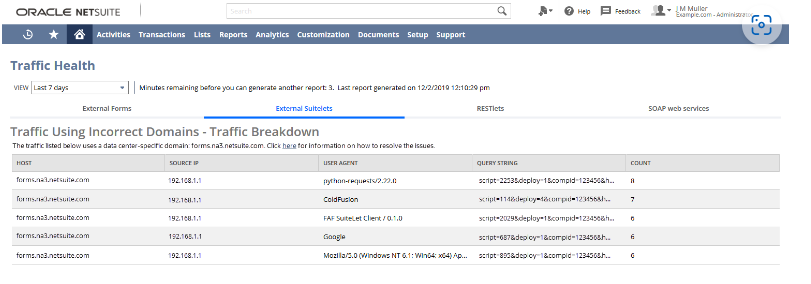To correct the items reported for External Suitelets:
- Click External Suitelets.
- If you see the message No records to show, your external Suitelets are using account-specific domains.
- If you see items listed in this section of the report, you must identify the non-compliant traffic, and determine the severity.
- Use the number in the Count column to determine the priority of the updates you should make. The higher the count, the higher the priority to make updates to use an account-specific domain.
- Column Name
- How This Information Can Help You Identify the Traffic
- Host
- Domain name (Host header) associated with an incoming HTTP request.
- Source IP
- Originating IP address of the request.
- Indicates the IP address that NetSuite sees as the IP address from which the traffic originates. This IP address may be translated by a NAT (Network Address Translation) device, which operates in the network where your integration server runs.
- User Agent
- A user agent is software that acts on behalf of the user. Browsers are one type of user agent. The information in this column can identify the application type, operating system, software vendor, or software version of the requesting software user agent.
- The user agent indicates the name of your HTTP or integration client. The user agent may contain the name of the programming language used to create the integration client. The user agent can also indicate whether the external Suitelet is invoked from a website or from a standalone script (for example, a python script).
- Query String
- Includes the Script ID or Deployment ID of the script. You do not need to locate the particular script using those IDs. The problem is with the user agent that is calling the script.
- The script, or query string parameter, identifies the external Suitelet ID instance being called. Determining the purpose of the external Suitelet will help you to narrow down the scope of integration clients that need to be updated.
- Response Code
- HTTP response status code.
- Failures of requests using a data center-specific URL with 200, 300, and 500 series response codes are listed in this report.
- 200 series response codes: The request was processed, but it does not mean the request routing (the domain used in the request) is correct.
- 300 series response codes: Indicate that the response was redirected. However, it also indicates that the request routing (the domain used in the request) should be fixed.
- Examples of some of the 300 series response codes include:
- 301 Moved Permanently
- 302 Found
- 308 Permanent Redirect
- 500 series response codes: The operation failed on the NetSuite side because the server could not process the response.
- You may need to fix the request routing (the domain used in the request).
- You should also investigate what else may be wrong with the request that caused the server to fail to process the request.
- For more information about these codes, refer to the following websites:
- Mozilla: HTTP response status codes
- Wikipedia: List of HTTP status codes
- Count
- The number of times during the reporting period that the traffic with the same parameters used a data center-specific domain.
- Count can help you to determine the severity of the problem. Prioritize correcting line items with a high value in the Count column. A higher number indicates a larger volume of traffic is using a data center-specific URL.
- After you have updated all of the external Suitelets listed in the original report, generate a fresh report to validate there are no external Suitelets in your account that are using data center-specific domains.
- Repeat this entire procedure as needed to continue correcting items listed on your Traffic Health report until no items remain in the list.
